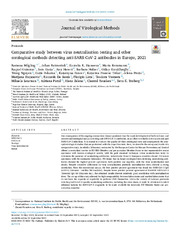| dc.creator | Mögling, Ramona | |
| dc.creator | Reimerink, Johan | |
| dc.creator | Stanoeva, Kamelia R. | |
| dc.creator | Keramarou, Maria | |
| dc.creator | Guiomar, Raquel | |
| dc.creator | Costa, Inês | |
| dc.creator | Haveri, Anu | |
| dc.creator | Holzer, Barbara | |
| dc.creator | Korukluoğlu, Gülay | |
| dc.creator | Nguyen, Trung | |
| dc.creator | Pakarna, Gatis | |
| dc.creator | Pancer, Katarzyna | |
| dc.creator | Trilar, Katarina Prosenc | |
| dc.creator | Protić, Jelena | |
| dc.creator | Stojanović, Marijana | |
| dc.creator | De Santis, Riccardo | |
| dc.creator | Lista, Florigio | |
| dc.creator | Vremera, Teodora | |
| dc.creator | Leustean, Mihaela | |
| dc.creator | Pistol, Adriana | |
| dc.creator | Zelena, Hana | |
| dc.creator | Reusken, Chantal | |
| dc.creator | Broberg, Eeva K. | |
| dc.date.accessioned | 2023-10-16T08:30:54Z | |
| dc.date.available | 2023-10-16T08:30:54Z | |
| dc.date.issued | 2023 | |
| dc.identifier.issn | 0166-0934 | |
| dc.identifier.uri | http://intor.torlakinstitut.com/handle/123456789/805 | |
| dc.description.abstract | One consequence of the ongoing coronavirus disease pandemic was the rapid development of both in-house and commercial serological assays detecting anti-SARS-CoV-2 antibodies, in an effort to reliably detect acute and past SARS-CoV-2 infections. It is crucial to evaluate the quality of these serological tests and consequently the sero-epidemiological studies that are performed with the respective tests. Here, we describe the set-up and results of a comparative study, in which a laboratory contracted by the European Centre for Disease Prevention and Control offered a centralised service to EU/EEA Member and pre-accession Member States to test representative serum specimens with known serological results, with the gold standard technique (virus neutralisation tests) to determine the presence of neutralising antibodies. Laboratories from 12 European countries shared 719 serum specimens with the contractor laboratory. We found that in-house serological tests detecting neutralising antibodies showed the highest percent agreement, both positive and negative, with the virus neutralisation test results. Despite extensive differences in virus neutralisation protocols neutralisation titres showed a strong correlation. From the commercial assays, the best positive percent agreement was found for SARS-CoV-2 IgG (sCOVG) (Siemens - Atellica IM Analyzer). Despite lower positive percent agreement of LIAISON SARS-CoV-2 TrimericS IgG kit (Diasorin Inc.), the obtained results showed relatively good correlation with neutralisation titres. The set-up of this study allowed for high comparability between laboratories and enabled laboratories that do not have the capacity or capability to perform VNTs themselves. Given the variety of in-house protocols detecting SARS-CoV-2 specific neutralising antibodies, including the virus strain, it could be of interest to select reference isolates for SARS-CoV-2 diagnostic to be made available for interested EU Member States and pre-accession countries. | |
| dc.publisher | Elsevier | |
| dc.relation | European Centre for Disease Prevention and Control (ECDC) under direct contract No ECD.11508 | |
| dc.rights | openAccess | |
| dc.rights.uri | https://creativecommons.org/licenses/by-nc/4.0/ | |
| dc.source | Journal of Virological Methods | |
| dc.subject | COVID-19 | |
| dc.subject | Europe | |
| dc.subject | SARS-CoV-2 | |
| dc.subject | Serology | |
| dc.subject | Virus neutralisation | |
| dc.title | Comparative study between virus neutralisation testing and other serological methods detecting anti-SARS-CoV-2 antibodies in Europe, 2021 | |
| dc.type | article | en |
| dc.rights.license | BY-NC | |
| dc.citation.rank | M22~ | |
| dc.citation.spage | 114825 | |
| dc.citation.volume | 322 | |
| dc.identifier.doi | 10.1016/j.jviromet.2023.114825 | |
| dc.identifier.fulltext | http://intor.torlakinstitut.com/bitstream/id/1885/Comparative_study_between_VoR_2023.pdf | |
| dc.type.version | publishedVersion | |

